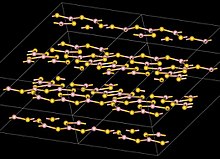
Back كبريتيد البورون Arabic سولفید بور AZB Bortrisulfid German سولفید بور Persian Boorisulfidi Finnish Sulfure de bore French 硫化ホウ素 Japanese Boorsulfide Dutch Sulfeto de boro Portuguese Сульфид бора Russian

| |
| Names | |
|---|---|
| IUPAC name
Boron sulfide
| |
| Other names
Boron sesquisulfide, Diboron trisulfide
| |
| Identifiers | |
3D model (JSmol)
|
|
| ECHA InfoCard | 100.031.355 |
| EC Number |
|
PubChem CID
|
|
CompTox Dashboard (EPA)
|
|
| |
| |
| Properties | |
| B2S3 | |
| Molar mass | 117.80 g/mol |
| Appearance | colorless crystals |
| Density | 1.55 g/cm3, solid |
| Melting point | 563 °C (1,045 °F; 836 K) |
| Boiling point | decomposes at high T |
| decomposes | |
| Solubility | soluble in ammonia |
| Structure | |
| monoclinic, mP40, SpaceGroup = P21/c, No. 14 | |
| B: planar, sp2 | |
| Thermochemistry | |
Heat capacity (C)
|
111.7 J/mol K |
Std molar
entropy (S⦵298) |
327 J/mol K |
Std enthalpy of
formation (ΔfH⦵298) |
-240.6 kJ/mol |
| Hazards | |
| Occupational safety and health (OHS/OSH): | |
Main hazards
|
source of H2S |
| GHS labelling: | |
  
| |
| Danger | |
| H225, H260, H301, H311, H315, H318, H335 | |
| P210, P223, P231+P232, P280, P302+P352, P303+P361+P353, P305+P351+P338, P312, P402+P404, P405 | |
| NFPA 704 (fire diamond) | |
| Flash point | 18°C (64.4°F) |
| Safety data sheet (SDS) | trc-canada.com |
| Related compounds | |
Related compounds
|
BCl3 Lawesson's reagent |
Except where otherwise noted, data are given for materials in their standard state (at 25 °C [77 °F], 100 kPa).
| |
Boron sulfide is the chemical compound with the formula B2S3. It is a white, moisture-sensitive solid. It has a polymeric structure. The material has been of interest as a component of "high-tech" glasses and as a reagent for preparing organosulfur compounds.
- ^ Material Safety Data Sheet, VWR, 2010, retrieved November 11, 2023
